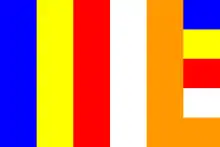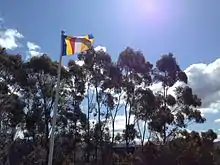Buddhist flag
The Buddhist flag is a flag designed in the late 19th century as a universal symbol of Buddhism.[1] It is used by Buddhists throughout the world.[1]


History

The flag was originally designed in 1885 by the Colombo Committee, in Colombo, Ceylon (now Sri Lanka). The committee consisted of Ven. Hikkaduwe Sri Sumangala Thera (chairman), Ven. Migettuwatte Gunananda Thera, Don Carolis Hewavitharana (father of Anagarika Dharmapala), Andiris Perera Dharmagunawardhana (maternal grandfather of Anagarika Dharmapala), Charles A. de Silva, Peter De Abrew, William De Abrew (father of Peter), H. William Fernando, N. S. Fernando and Carolis Pujitha Gunawardena (secretary).[2]
It was first publicly hoisted on Vesak day, 28 April 1885[1] at the Dipaduttamarama, Kotahena, by Ven. Migettuwatte Gunananda Thera.[3] This was the first Vesak public holiday under British rule.[3]
Colonel Henry Steel Olcott, an American journalist, founder and first president of the Theosophical Society, felt that its long streaming shape made it inconvenient for general use. He therefore suggested modifying it so that it was the size and shape of national flags.[1]
In 1889, the modified flag was introduced to Japan by Anagarika Dharmapala and Olcott—who presented it to Emperor Meiji—and subsequently to Burma.[4]
At the 1950 World Fellowship of Buddhists, the flag of Buddhists was adopted as the International Buddhist Flag.[5]
Colors
The flag's six vertical bands represent the six colors of the aura which Buddhists believe emanated from the body of the Buddha when he attained Enlightenment:[6][1]
Blue (Pāli and Sanskrit: nīla): The Spirit of Universal Compassion
Yellow (Pāli and Sanskrit: pīta): The Middle Way
Red (Pāli and Sanskrit: lohitaka): The Blessings of Practice – achievement, wisdom, virtue, fortune and dignity
White (Pāli: odāta; Sanskrit: avadāta): The Purity of Dhamma – leading to liberation, timeless
Orange (Pāli: mañjeṭṭha; Sanskrit: mañjiṣṭhā - alternatively scarlet): The Wisdom of the Buddha's teachings
The sixth vertical band, on the fly, is made up of a combination of the five other colors' rectangular bands, and represents a compound of said colors in the aura's spectrum. This new, compound color is referred to as the Truth of the Buddha's teaching or Pabbhassara ('essence of light').
Variants


The nonsectarian Buddhist flag is flown over the temples of many different schools. However, some choose to change the colors of the flag to emphasize their own teachings.
- In Japan, there is a traditional Buddhist flag (五色幕—goshikimaku) which has different colors but is sometimes merged with the design of the international flag to represent international cooperation.
- In Tibet, the stripes' colors represent the different colors of Buddhist robes comprehensively united in one banner. Tibetan monastic robes are maroon, so the orange stripes in the original design are often replaced with maroon.
- Tibetan Buddhists in Nepal replace the orange stripes with plum stripes.
- Theravāda Buddhists in Myanmar replace orange with pink, the color of the robe of the country's bhikkhunīs.
- Theravāda Buddhists in Thailand opt the usage of a yellow flag with a red dhammacakka; it is sometimes paired with the international Buddhist flag.
- Soka Gakkai uses a tricolor of blue, yellow, and red.[7] It is often mistaken to the flag of Romania.
 Tibetan Buddhist flag.
Tibetan Buddhist flag. Burmese Buddhist flag.
Burmese Buddhist flag. Nepalese Buddhist flag.
Nepalese Buddhist flag. Japanese Buddhist flag "goshikimaku" (五色幕).
Japanese Buddhist flag "goshikimaku" (五色幕). A common variant with the dharmachakra.
A common variant with the dharmachakra. Flag of Soka Gakkai.
Flag of Soka Gakkai. Laotian Buddhist flag.
Laotian Buddhist flag..svg.png.webp) Thai Buddhist flag (The dhammacakka flag, Thong Dhammacak ธงธรรมจักร).
Thai Buddhist flag (The dhammacakka flag, Thong Dhammacak ธงธรรมจักร). Korean Buddhist swastika flag.
Korean Buddhist swastika flag. Karma Kagyu flag (Rangjung Rigpe Dorje, 16th Karmapa's "dream flag").
Karma Kagyu flag (Rangjung Rigpe Dorje, 16th Karmapa's "dream flag").
Ban
In 1963, the Catholic President of South Vietnam Ngo Dinh Diem invoked a law prohibiting flags other than that of the nation, to ban the Buddhist flag from being flown on Vesak, when Vatican flags had habitually flown at government events. This led to protests, which were ended by lethal firing of weapons, starting the Buddhist crisis.[8]
References
- "The Origin and Meaning of the Buddhist Flag". The Buddhist Council of Queensland. Retrieved 2 April 2015.
- The Maha Bodhi, Volumes 98–99; Volumes 1891–1991. Maha Bodhi Society. 1892. p. 286.
- Lopez, Jr., Donald S. (2002). A Modern Buddhist Bible: Essential Readings from East and West. Beacon Press. p. xiv. ISBN 9780807012437.
- "Buddhist flag marks 125th anniversary". Sunday Observer. 16 March 2010. Retrieved 8 November 2018.
- Wilkinson, Phillip (2003). DK Eyewitness Books: Buddhism. Penguin Putnam. p. 64. ISBN 9781782682875.
- "The Buddhist Flag". Buddhanet. Retrieved 2 April 2015.
- "Flags of the World: Buddhism". Archived from the original on 24 September 2008. Retrieved 2008-09-24.
- Zachary., Abuza (2001). Renovating politics in contemporary Vietnam. Boulder: L. Rienner Publishers. p. 191. ISBN 1588261778. OCLC 65180894.
External links
| Wikimedia Commons has media related to Buddhist flag. |